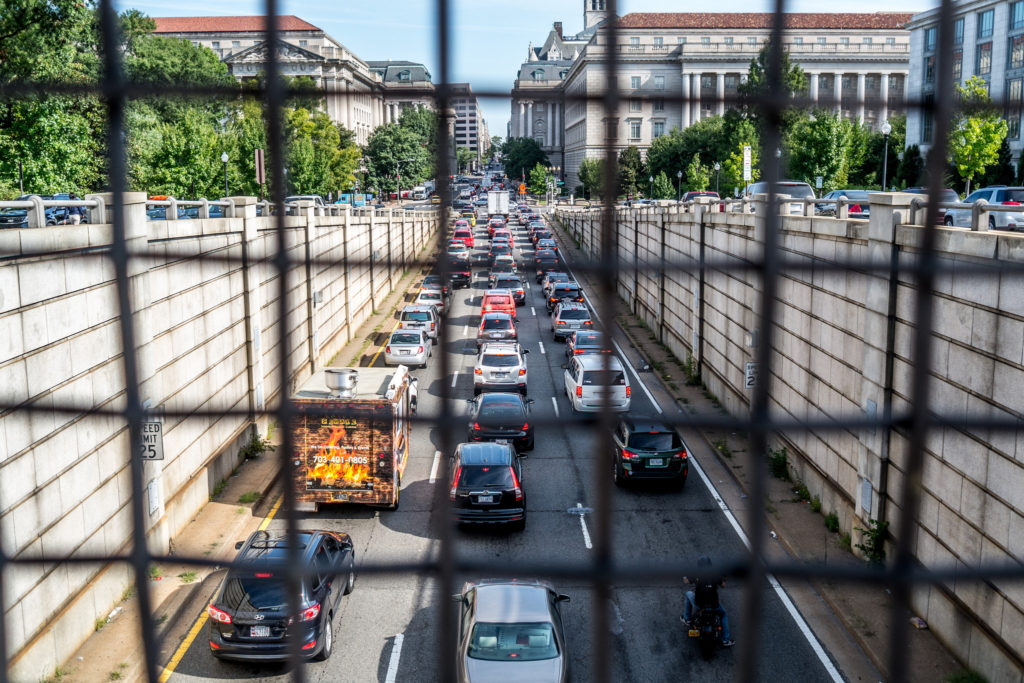The infamous “Terry Tolls” are now getting a revamp as a contingent of corporate heavyweights push for a regional toll network to interconnect travel lanes from Richmond to Baltimore. The group claims that the region should “embrace” tolls to improve the reliability of roadways and reduce congestion for all, while generating a lucrative funding source for creating new infrastructure.
The group includes a 21-member board of directors with prominent executives from many of the biggest companies in Virginia, Maryland, and Washington, D.C. It includes Ted Leonsis, owner of the Washington Wizards and the Washington Capitals; chief executive Wesley G. Bush of Northrop Grumman; chief executive Kevin Plank of Under Armour; co-chief executive David M. Rubenstein of Carlyle Group; Tom Farrell of Dominion Energy; Richard Fairbank of Capital One; Chris Crane of Exelon; and Sheila Johnson of Salamander Hotels & Resorts.
In a report from The Washington Post, Joe McAndrew, director of transportation policy for the Greater Washington Partnership, says to successfully grow the toll road network, “We need to be thinking about this to incorporate and benefit the broader transportation system.” He added, “We have done tolling separately in Virginia and Maryland, but we really need to do this as a region.”
The capital-area group is pushing for regional consensus on tolling at an “opportune time,” seeking to boost support for a Maryland proposal to add toll lanes to parts of the Capital Beltway linked with Interstate 270 and capitalize on growth of tolling across the Potomac River in Northern Virginia. Nearly 55 miles of express lanes have opened on Interstates 495, 95, and 66 within the past five years, which continue to grow in number.
The group says that Maryland’s plan offers an opportunity to enhance traffic flow by reducing congestion, improving roadway reliability, and boosting mobility for daily commuters. Furthermore, it would provide connectivity with the Virginia toll network by way of the American Legion and Woodrow Wilson bridges.
As Virginia seeks to add an eight-mile stretch of express lanes on I-395 and another 22 miles of toll lanes on I-66 beyond the Beltway, the Commonwealth will create a network of high-occupancy toll (HOT) lanes stretching 90 miles by 2022.
Former deputy U.S. transportation secretary and Maryland transportation chief John Porcari says as the regional toll network is discussed and planned, the group and transportation officials should ask the questions: “Is the tolling revenue helping the entire transportation system including public transit? Is it accessible and usable for consumer of all income levels?”
“There has to be a framework to build the connectivity of the region,” Porcari said, who also serve’s on the partnership’s mobility steering committee.
Recently, the partnership penned a position paper that outlined a formula for the construction and planning of the network. They state that tolling should be coordinated in a regional fashion to deliver the benefits of greater mobility and reliability.
The revenue generated from tolls should be used to improve public transportation, and the investments should benefit not only the tolled facility but the greater transportation system of the Richmond-to-Baltimore infrastructure.
As well, the region should ensure the toll facilities benefit people of all income levels, suggesting programs such as free tolling accounts to ensure people of lower incomes can access them.
The last stipulation is one that had head spinning this year as peak pricing on the I-66 toll road going into Washington during morning rush hour hit $47, causing quite of a ruckus on Twitter. McAndrew said congestion-priced tolling has proved to be effective, despite the widespread criticism.
Data from the Virginia Department of Transportation (VDOT) shows that commutes on the 10-mile stretch of road are more consistent. Presumably, because many drivers arrive to work with empty pockets and elect to use the longer, local routes into Washington.
The system allows carpoolers and bus riders to ride free, while giving solo drivers the choice to pay high prices. The tolls are “dynamic,” meaning they change according to demand and volume of traffic to maintain an average vehicle speed.
Of course, many daily commuters and driver’s advocates are skeptical about any proposal that calls for more tolls, especially on existing highways.
John Townsend, a spokesman for AAA Mid-Atlantic, commented on the proposal by the partnership. “Most motorists are leery of congestion-priced tolling because people in the region drive because they have to, not because they want to,” Townsend said.
“Attitudes are not as hardened if the priced lanes are optional,” he said. “Motorists are troubled by congestion pricing because of equity concerns and its impact on commuters with household incomes under a certain strata.”
McAndrew argues that the toll network could ease the annual cost of congestion, which their report states costs $7 billion. Moreover, on average, Washington metro-area commuters lose $1,834 annually – the highest in the nation, the report shows.
The group also is planning to push for the implementation of a common “farecard system” that can be used on Metro, commuter and intercity rail systems, a redesign of the regional bus networks, and other services within the region.
Even though the group says congestion-priced toll roads and an interconnected transportation infrastructure could ease travel along the mid-Atlantic corridor, it still is just a bandage on the problem at hand, albeit a big Band-Aid.

